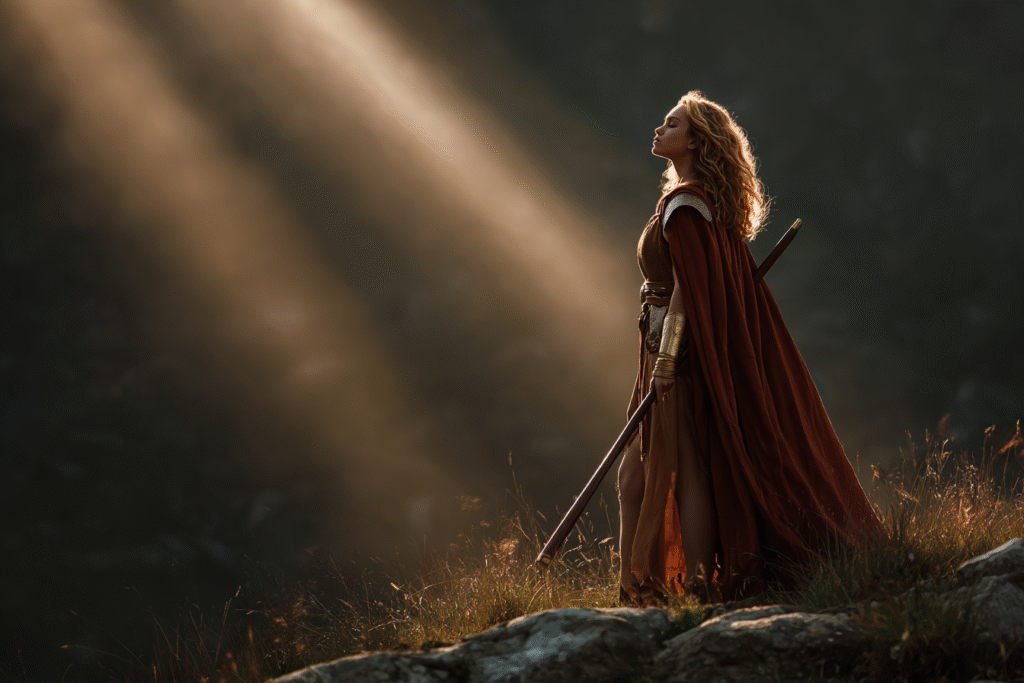
from SRP author Tracy Cooper-Posey:
We romance readers—and writers—have always known women were the real backbone of society. Now archaeology is finally catching up. This month, a tantalizing discovery in England’s Dorset region has added new weight to the idea that Iron-Age Celtic tribes might have been far more woman-centered than historians (and most fiction) have dared admit.
And I am so here for it.
The Dorset Dig that Turned Heads
Archaeologists recently unearthed a teenage girl buried near the Iron Age settlement of Winterborne Kingston. She was buried alone in a crouched position and appears to have died violently, possibly as a ritual sacrifice. (We’re not going to dwell on that. It’s awful, it happened, we’re moving on.)
What really got everyone’s attention wasn’t just her grave, but what was discovered across the whole site: dozens of skeletons, all part of a settlement linked to the Celtic Durotriges tribe.
And once scientists pulled DNA from those bones, everything changed.
Matrilocal, Matrilineal, and Maybe… Matriarchal?
Let’s unpack this without the academic hand-waving.
- Matrilocal means when a couple marries, the husband moves in with the wife’s family or tribe. She stays put. Her world doesn’t revolve around his.
- Matrilineal means inheritance or family ties are traced through the mother’s line. Your identity is shaped by your mother, not your father.
- Matriarchal? That’s the golden word. It means women hold the power—social, political, and economic. Think queens, priestesses, and clan heads.
Now, this Dorset site doesn’t give us solid proof of full-blown matriarchy. But what it does show is that women were the anchor of the community.
DNA analysis revealed that the majority of people buried there shared the same maternal haplotype. Translation: these people were born of the same maternal line—and they stayed together. Women lived and died in the same place. Meanwhile, the Y-chromosome data (that’s the male line) was wildly diverse. Meaning? The men came from somewhere else.
Hello, matrilocality.
So, What Does This Mean for Celtic Women?
It means that Iron Age women in this tribe didn’t leave their families behind when they married. The men moved in with them.
That one detail flips so many common assumptions. In most ancient societies (especially in Europe), women were “married out” to strengthen alliances or produce heirs somewhere else. They left everything they knew behind.
Not here.
In this community, women stayed rooted. Their daughters stayed, too. That creates incredibly strong kinship networks, with women at the center of daily life, family decisions, and—let’s be real—probably a whole lot of informal governance. And the men? They came in as guests. (Some likely made themselves at home. Others may have been reminded who ran the show.)
And if that doesn’t sound like the start of half the great romance plots we all love, I don’t know what does.
Why This is Such a Big Deal
This isn’t just a quaint tribal quirk. This kind of female-centered structure is rare in prehistoric Europe. Patrilocal and patrilineal systems (where women marry out and men hold power) were the norm across most of the ancient world.
To find solid, DNA-confirmed evidence of a society where women didn’t just survive but held their ground—literally—is like finding a matriarchal unicorn.
Even the researchers were surprised. One called it “an unusual but robustly supported case.” Which in science-speak means: “We didn’t expect this, but the data slapped us in the face.”

Your Favorite Celtic Heroines? They Were Closer to the Truth Than We Thought
If you’ve been reading the Once and Future Hearts series (and judging by the emails I get, many of you have), then you know I’ve always leaned into the idea that Celtic women were fierce, powerful, and far more central to society than the Roman chroniclers liked to admit.
Turns out, I might’ve been too cautious.
I reined in the matriarchal elements to stay within the boundaries of what historians “allowed.” But now? Now we have genomic receipts. Women weren’t just the fierce battle queens or tragic sacrifices. They were the glue holding everything together. The land belonged to them. The family was theirs. And the men—bless them—were often just trying to find their place in the women’s world.
What This Means for Storytelling
From a writer’s perspective, this changes everything. It gives us permission to reimagine Iron-Age Britain not just with strong female characters, but with entire systems built around women’s roles, power, and presence.
Imagine a heroine who doesn’t have to “fight for her place in a man’s world” because the world is already hers.
Imagine her dealing with incoming husbands (plural?), property disputes among sisters, or external threats from patriarchal neighbors who don’t understand that “she” isn’t just a girl—she’s the whole damn foundation.
The story possibilities explode.
One Last Caveat (Because You Know I Love Those)
This doesn’t mean every Celtic tribe was matrilocal. Or that all women had equal power. Even in this female-centered structure, violence against women still happened—like our tragic teenage girl in Dorset.
But it does mean that the default assumption of male-dominated societies needs to be reexamined. It gives us a new lens to see the past—and our heroines—in sharper, stronger relief.
Final Thought
So the next time someone tries to tell you Celtic women were just mythic exceptions—warrior queens, noble sacrifices, or tragic love interests—you can point to Dorset and say, “Actually, they were the rule.”
And you’ve got the science to back it up.

Tracy Cooper-Posey
SRP Author



